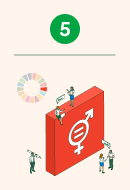Gender employment gap
The EU and its Member States must strengthen their efforts to achieve equality between women and men
Employment Women Gender equality
Women represent more than half of the graduates in the European Union. However, many still face significant barriers to enter the job market, resulting in a significant gender gap in employment data across the continent.

The gender employment gap is evident throughout Europe: at the end of 2023, the average employment rate for women aged 20-64 was 70.2%, compared to 80.4% for men, resulting a difference in employment rate between men and women of 10.2 percentage points, according to data published by Eurostat.
The same study also shows that the gender gap in employment varies significantly between EU Member States. In the period analysed, the lowest gap was recorded in Finland (0.2%), followed by Lithuania (1.5%), Estonia (2.4%) and Latvia (3.1%). At the other end of the scale, the countries with the largest differences were Romania (19.1%), Italy (19.5%) and Greece (19.8%).
Despite the fact that the average gender employment gap in Europe is decreasing with each passing year – it was 10.9% in 2021 and 10.7% in 2022 – European women still face a number of problems when it comes to accessing the job market. In the face with this problem, the European Commission, in the context of the European Pillar of Social Rights, has set different objectives for 2030, one of which is to reduce the gender employment gap by at least half compared to the figure for 2019 (11.7%).
Women: conquering equality
Global labour-force participation rate for women (2023)
0.0% of the global workforce is represented by women
0% of senior leadership positions are held by women
Source: Linkedin Economic Graph
Women’s participation across industries in the global labour market








Source: Global Gender Gap Index 2024
 SEE INFOGRAPHIC: Women, conquering equality [PDF]
SEE INFOGRAPHIC: Women, conquering equality [PDF]
This trend is also observed in other elements of the world of work, such as wages. In 2021, the gap between men's and women's gross earnings in the EU stood at 12.7%, meaning that women earned, on average, 13% less per hour than men that year. This figure is even greater in countries such as Estonia (20.5%), Austria (18.8%) and Germany (17.6%), indicating that significant wage inequalities persist in several Member States.
According to the European Commission, the gender pay gap today measures a broader concept than just wage discrimination and encompasses a large number of inequalities that women face in access to work. They are:
 Sectorial segregation: around 24% of the gender pay gap is related to the over-representation of women in lower paid sectors such as care, health and education.
Sectorial segregation: around 24% of the gender pay gap is related to the over-representation of women in lower paid sectors such as care, health and education.  Unequal sharing of paid and unpaid work: women work more hours per week than men, but spend more hours on unpaid work, which may also affect their career choices.
Unequal sharing of paid and unpaid work: women work more hours per week than men, but spend more hours on unpaid work, which may also affect their career choices.  Position in the hierarchy influences pay levels: less than one in ten CEOs in top companies are women.
Position in the hierarchy influences pay levels: less than one in ten CEOs in top companies are women. Pay discrimination: In some cases, women earn less than men for equal work or work of equal value, even though the principle of equal pay has been enshrined in the Treaty on the Functioning of the European Union since 1957.
Pay discrimination: In some cases, women earn less than men for equal work or work of equal value, even though the principle of equal pay has been enshrined in the Treaty on the Functioning of the European Union since 1957.

Women at Iberdrola
Our aim is to continue to make progress until we consolidate our position as an international benchmark in equality.

Women in STEM careers
We support the professional development of women in areas such as science and engineering.

HerEnergy
The programme seeks to make visible, accelerate and expand the development of women in our business.

SDG 5
Iberdrola is committed to achieving the goal set by the United Nations on gender equality.
Or commitment to gender equality at work
Iberdrola has various initiatives to promote gender equality in the workplace in the various geographies where it operates. Over the past few decades, practices have been implemented to create the conditions necessary for all professionals – men and women – to be able to occupy the position they deserve with equal opportunities, such as leaves of absence or support for maternity/paternity.
These initiatives have resulted in a significant increase in both women hires and their promotion to positions of responsibility. According to our Diversity and Inclusion Report 2023, 28% of top positions in the company are covered by women, up from 26% in 2022. The target is for this figure to reach 30% by 2025 and 35% by 2030.
Furthermore, in 2007 Iberdrola became the first Ibex-35 company to implement a continuous working day throughout the year. This measure, which was based on its Equal Opportunities and Reconciliation Policy, now called the Diversity and Inclusion and Harassment Prevention Policy, placed the company at the forefront of the adoption of measures that strike a balance between work and family life in its jobs.




